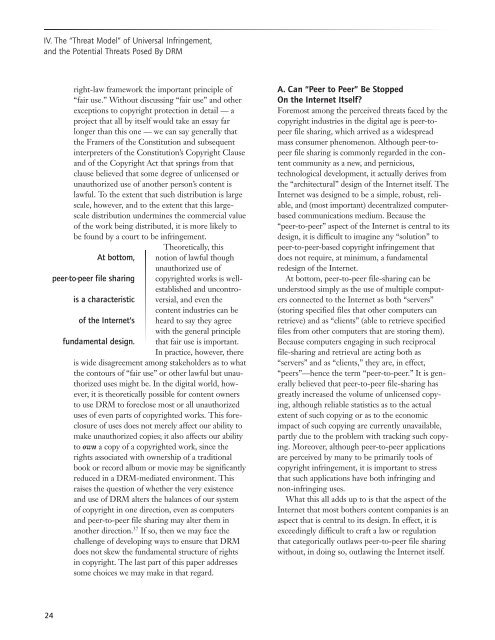What Every Citizen Should Know About DRM, aka - Public Knowledge
What Every Citizen Should Know About DRM, aka - Public Knowledge
What Every Citizen Should Know About DRM, aka - Public Knowledge
You also want an ePaper? Increase the reach of your titles
YUMPU automatically turns print PDFs into web optimized ePapers that Google loves.
IV. The “Threat Model” of Universal Infringement,and the Potential Threats Posed By <strong>DRM</strong>right-law framework the important principle of“fair use.” Without discussing “fair use” and otherexceptions to copyright protection in detail — aproject that all by itself would take an essay farlonger than this one — we can say generally thatthe Framers of the Constitution and subsequentinterpreters of the Constitution’s Copyright Clauseand of the Copyright Act that springs from thatclause believed that some degree of unlicensed orunauthorized use of another person’s content islawful. To the extent that such distribution is largescale, however, and to the extent that this largescaledistribution undermines the commercial valueof the work being distributed, it is more likely tobe found by a court to be infringement.Theoretically, thisAt bottom, notion of lawful thoughunauthorized use ofpeer-to-peer file sharing copyrighted works is wellestablishedand uncontroversial,and even theis a characteristiccontent industries can beof the Internet’s heard to say they agreewith the general principlefundamental design. that fair use is important.In practice, however, thereis wide disagreement among stakeholders as to whatthe contours of “fair use” or other lawful but unauthorizeduses might be. In the digital world, however,it is theoretically possible for content ownersto use <strong>DRM</strong> to foreclose most or all unauthorizeduses of even parts of copyrighted works. This foreclosureof uses does not merely affect our ability tomake unauthorized copies; it also affects our abilityto own a copy of a copyrighted work, since therights associated with ownership of a traditionalbook or record album or movie may be significantlyreduced in a <strong>DRM</strong>-mediated environment. Thisraises the question of whether the very existenceand use of <strong>DRM</strong> alters the balances of our systemof copyright in one direction, even as computersand peer-to-peer file sharing may alter them inanother direction. 37 If so, then we may face thechallenge of developing ways to ensure that <strong>DRM</strong>does not skew the fundamental structure of rightsin copyright. The last part of this paper addressessome choices we may make in that regard.A. Can “Peer to Peer” Be StoppedOn the Internet Itself?Foremost among the perceived threats faced by thecopyright industries in the digital age is peer-topeerfile sharing, which arrived as a widespreadmass consumer phenomenon. Although peer-topeerfile sharing is commonly regarded in the contentcommunity as a new, and pernicious,technological development, it actually derives fromthe “architectural” design of the Internet itself. TheInternet was designed to be a simple, robust, reliable,and (most important) decentralized computerbasedcommunications medium. Because the“peer-to-peer” aspect of the Internet is central to itsdesign, it is difficult to imagine any “solution” topeer-to-peer-based copyright infringement thatdoes not require, at minimum, a fundamentalredesign of the Internet.At bottom, peer-to-peer file-sharing can beunderstood simply as the use of multiple computersconnected to the Internet as both “servers”(storing specified files that other computers canretrieve) and as “clients” (able to retrieve specifiedfiles from other computers that are storing them).Because computers engaging in such reciprocalfile-sharing and retrieval are acting both as“servers” and as “clients,” they are, in effect,“peers”—hence the term “peer-to-peer.” It is generallybelieved that peer-to-peer file-sharing hasgreatly increased the volume of unlicensed copying,although reliable statistics as to the actualextent of such copying or as to the economicimpact of such copying are currently unavailable,partly due to the problem with tracking such copying.Moreover, although peer-to-peer applicationsare perceived by many to be primarily tools ofcopyright infringement, it is important to stressthat such applications have both infringing andnon-infringing uses.<strong>What</strong> this all adds up to is that the aspect of theInternet that most bothers content companies is anaspect that is central to its design. In effect, it isexceedingly difficult to craft a law or regulationthat categorically outlaws peer-to-peer file sharingwithout, in doing so, outlawing the Internet itself.24





